The widest variety of tree frogs in the U.S. is mostly found in the central and southeastern states, with a notable concentration in Florida. Florida’s tree frogs offer a surprising diversity, boasting 17 different types. Tree frogs are small frogs that are excellent climbers due to their large toepads with adhesive disks that help them hold onto barks or twigs. They may spend their time hanging out in trees, but they all must find water to breed. While many frogs like to spend some time in trees, true tree frogs belong to the family Hylidae.
These frogs start as tadpoles and breed near bodies of water, so they also often live near the breeding sites. Florida’s 1,350 miles of coastline and networks of protected wetlands provide optimal ecosystems for tree frogs to thrive. Add in the fact that most of Florida has a humid subtropical climate and it seems the perfect recipe for lots of frogs. In this article, we will learn more about the 17 types of tree frogs in Florida.
Tree Frogs in Florida
The 17 types of tree frogs in Florida are: Pine Barrens tree frog, Western Bird-voiced tree frog, Cope’s Gray tree frog, Green tree frog, Pine Woods tree frog, Barking tree frog, Squirrel tree frog, Northern Spring Peeper, Southern Spring Peeper, Cuban tree frog, Northern Cricket frog, Southern Cricket frog, Little Grass frog, Florida Chorus frog, Ornate Chorus frog, Upland Chorus frog, and Southern Chorus frog.
1. Pine Barrens Tree Frog
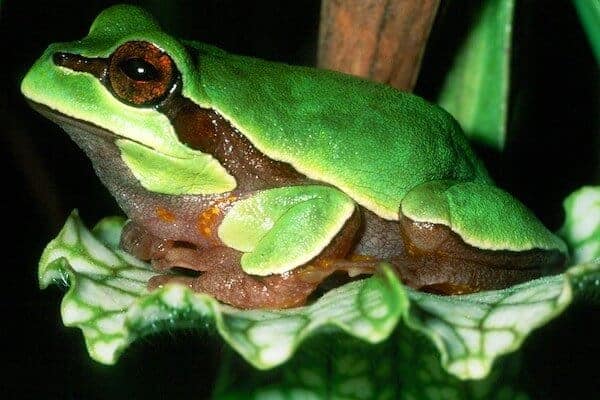
Scientific name: Hyla andersonii
The Pine Barrens tree frog has a smooth, bright green body with brownish-purple stripes running down each side. The legs, groin, and armpits have orange spots. They grow up to 2 inches in length as adults.
Pine Barren tree frogs call from April to September. The males do all the talking, and prefer to call when on the ground or near the surface of the water. Their call sounds like a “honk”, almost like a small bicycle horn. This species is of special concern in Florida and is only found in the panhandle.
2. Western Bird-Voiced Tree Frog
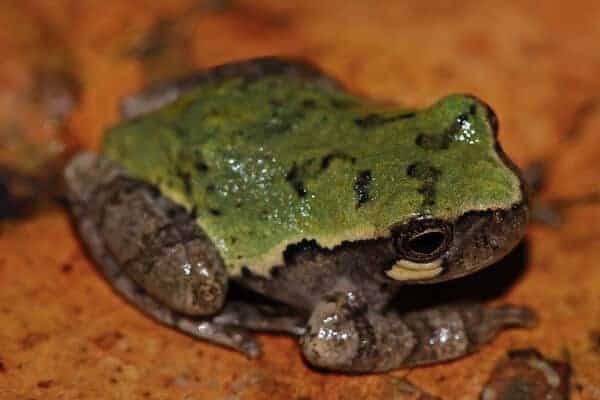
Scientific name: Hyla avivoca avivoca
The bird-voiced tree frog is typically 1 to 1.75 inches in length and is green, brown, or gray with dark blotches. They have a light spot under each eye which can vary in color. They spend most of their time in trees, only coming down to breed in shallow pools of swamps and creeks. Their main diet is spiders and tree dwelling insects. The unusual name refers to their call, which is described as a birdlike whistle. You can hear them between April and September. In Florida, they are only found in the western end of the panhandle.
3. Cope’s Gray Tree Frog
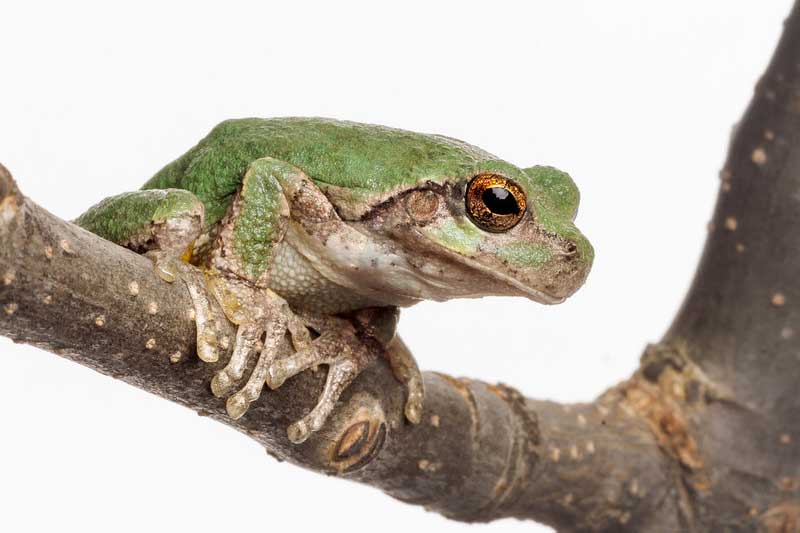
Scientific name: Hyla chrysoscelis
The Cope’s Gray tree frog is the only gray tree frog species in Florida and live in the northern region and panhandle. Their color ranges from orange, green, or brown to whitish gray, with dark blotches and white spots under the eyes. Adults are usually 1 to 2 inches in length.
While these frogs are called tree frogs and spend the majority of their time in trees, mating and egg fertilization occurs on the ground near water. The males climb up into the tree and make their mating calls high off the ground so the sound can travel and they have a better chance of finding a mate. Cope’s tree frogs often live near swamps or marshes, but also in prairies, meadows, fields, and forested areas near bodies of water.
4. Green Tree Frog

Scientific name: Hyla cinerea
The green tree frog has a slender, smooth body that’s bright to dark green or grayish. Their sides are usually marked with a white stripe with a crisp black border. Adults grow to a size of 1 to 2.5 inches in length. Most adults have a few orange or yellow spots on their backs.
During the day they hide in shady areas or under vegetation surrounding water. At night they come out to catch flying insects. The green tree frog call, heard from April to September, is a nasal quoonk-quoonk repeated up to 75 times per minute. These frogs live throughout Florida.
5. Pine Woods Tree Frog

Scientific name: Hyla femoralis
The pine woods tree frog usually has a distinctive facial mark looking like a “bandit mask.” Their body is green, gray, tan, or brown with darker blotches and bands. They are around 1.5 inches in length as adults.
Their preferred habitat is pine forests, flatwoods and cypress swamps. While they may climb all the way up the tall trees, they come down to breed in roadside ditches and small pools and ponds. They call from March to October. The call has a rapid metallic, machine-like sound and is often compared to morse code.
These frogs live throughout Florida except for the Keys and the south-central peninsula.
6. Barking Tree Frog
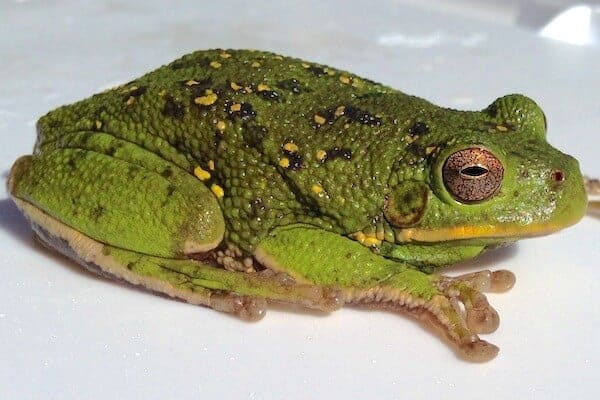
Scientific name: Hyla gratiosa
The barking tree frog has a plump body and uniquely granular bumpy skin that’s gray, green, or brown. Its back has dark spots that fade and sometimes yellow flecks. Adults average 2.5 inches in length and grow up to 2.75 inches.
Their call is a single “toonk” that is medium to deeper pitched. From a distance a group of these frogs often sounds like barking dogs. Most tree frogs sit on vegetation or the ground when they call, but the barking tree frog calls while floating on the water. These frogs are everywhere in Florida except the Keys and Everglades.
7. Squirrel Tree Frog

Scientific name: Hyla squirella
Squirrel tree frogs can change their color quickly to green, gray, tan, or brown with splotches and smooth skin. They often have a band of yellow that extends around their snout and down their sides. Adults usually grow to a length of 1 or 1.5 inches.
These tree frogs can inhabit a wide variety of settings, including urban areas and backyards. They may be found at night around windows or street lights, feasting on the insects the light attracts. They call for breeding between April and August. However they have a second call described as a “squirrel like rasp” that they perform before rain storms. This is gained them the nickname of “rain frogs”.
You can find the squirrel tree frog throughout Florida, including the Keys.
8. Northern Spring Peeper

Scientific name: Pseudacris crucifer crucifer
The northern spring peeper varies in color from dark brown to tan. They are small, varying in length between 0.75 to 1.38 inches. They are smaller and duller than the southern spring peeper. Spring peepers have a natural “antifreeze” in their blood that allows them to withstand freezing during the winter. They are well known for their call, which is very loud for a single frog let alone a group. Their chorus of “peeping” is a familiar sound on spring and summer evenings throughout the eastern half of the United States. They live in the northern Florida region.
9. Southern Spring Peeper
Scientific name: Pseudacris crucifer bartramiana
The southern spring peeper has a similar color and tolerance to cold conditions as the northern spring peeper, although they can be slightly larger and more darkly colored. Adults range in length between 0.9 and 1.5 inches. Their main distinction is a marking on their belly, and they are only found along the southern Gulf Coast. Despite their name, you can find them in the northern Florida region.
10. Cuban Tree Frog

Scientific name: Osteopilus septentrionalis
The Cuban tree frog is an invasive species in Florida and will eat native frogs, small snakes, and small lizards. They are native to Cuba, the Cayman Islands, and the Bahamas but now exist throughout Florida. These frogs’ colors vary from whitish or gray to brown or green with dark blotches or stripes. Usually, they are 1.5 to 3 inches in length but grow up to 5.5 inches.
11. Northern Cricket Frog
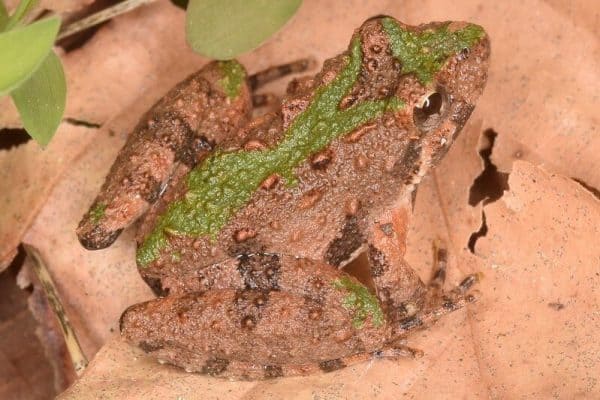
Scientific name: Acris crepitans
The northern cricket frog is only in the western panhandle of Florida at the edges of permanent water bodies or in vegetation. These frogs have warty, brown to grayish tan skin with a dark triangle mark on their heads and patches on their backs. They grow between 0.5 and 1.5 inches in length as adults. They have a stripe (color varies) that extends between the tops of their eyes and a “Y” shaped stripe on their back. The northern variety has more webbing on their back toes and the dark stripe on their thigh has ragged edges.
12. Southern Cricket Frog
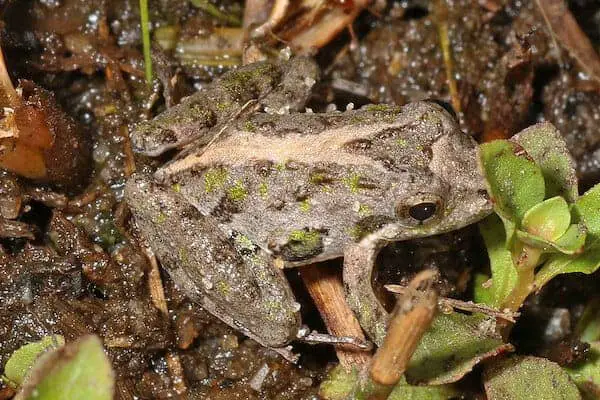
Scientific name: Acris gryllus
The southern cricket frog is similar to the northern cricket frog in color, size, and markings, including the triangular mark on its head. However, the southern cricket frog has a more pointed snout and doesn’t have as much webbing on its back legs. These frogs are in the far northwestern panhandle in Florida.
13. Little Grass Frog
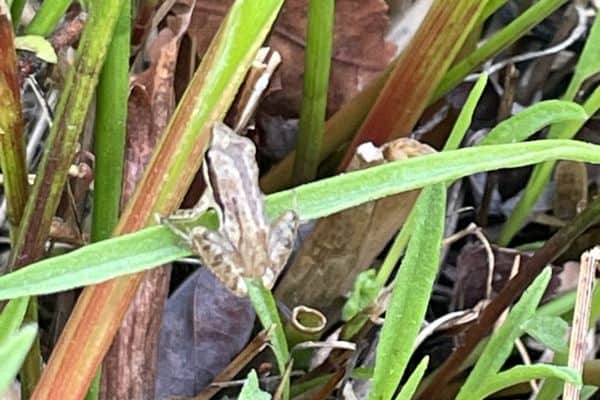
Scientific name: Pseudacris ocularis
Despite its name, the little grass frog is in the tree frog family of Hylidae and can climb trees. They are found throughout Florida, except the westernmost panhandle. These frogs are the smallest tree frogs in North America, ranging from 0.4 to 0.6 inches in length. Their bodies are generally green, pink, reddish, or brown.
The little grass frog likes moist but grassy habitats that are near ponds or wetlands. They can breed from January through September, but will call all year long. Their call is very high pitched and often sounds more like the chirping of an insect. For photos of the little grass frog, visit the University of Florida Department of Wildlife, Ecology & Conservation page here.
14. Florida Chorus Frog
Scientific name: Pseudacris nigrita verrucosa
The Florida chorus frog is a subspecies of the southern chorus frog, which is number 17 on this list. They are small frogs, reaching a maximum length of 1.25 inches, and can range from light to dark gray depending on how cold or warm they are. When they breed depends on their location in Florida. According to the University of Florida “Winter rains in northern Florida allow for winter and early spring breeding, while the rainy season in souther Florida occurs from spring to autumn.” They are found throughout most of Florida and have a secretive nature, so their actual population is unsure.
15. Ornate Chorus Frog
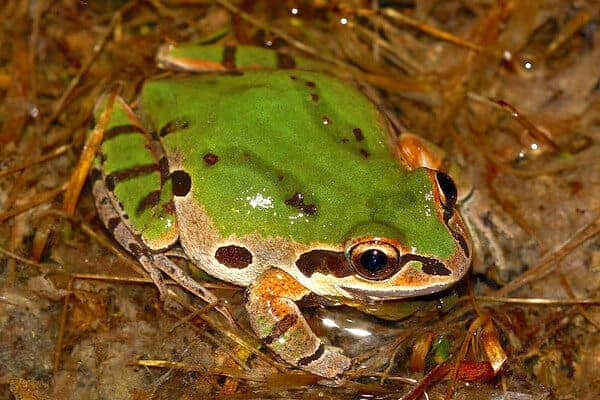
Scientific name: Pseudacris ornata
The adult ornate chorus frog is around 1.4 inches in length and has a more rounded snout than other chorus frogs. They always have dark spots on their sides, and a bold dark stripe that runs through each eye. They are often a reddish brown but can also be green or grayish. The ornate chorus frog is nocturnal and seldom seen outside of the active breeding season. You can find these frogs in northern Florida.
16. Upland Chorus Frog

Scientific name: Pseudacris feriarum
The upland chorus frog can appear various shades of brown, with a dark brown stripe running along their side. Their throat and chest are often a light cream color, and they grow up to 1.4 inches in length. Human activity doesn’t seem to scare them much, and they will inhabit small neighborhood ponds, flooded fields or roadside ditches. They like a moist, vegetated habitat near water, but spend very little time in the water itself. You will likely only see and hear them when breeding, and their most active breeding season is November through March.
The repetitive call of these frogs is sometimes described as sounding like running a finger along the teeth of a plastic comb. These frogs live in the forests of the Florida panhandle.
17. Southern Chorus Frog

Scientific name: Pseudacris nigrita
The southern chorus frog, a member of the diverse family of tree frogs of Florida, is characterized by its small and bumpy stature, growing up to 1.25 inches in length. Their color is tan, brown, or green-gray, and they have a pointed snout with a uniquely lighter bottom lip. There are three rows of dark spots on their back. These tree frogs live in pine flatwoods, forest wetlands, wet meadows and roadside ditches. Their call is a mechanical raspy trill that can be heard between January and March.
These frogs live throughout Florida in pineland habitats.


